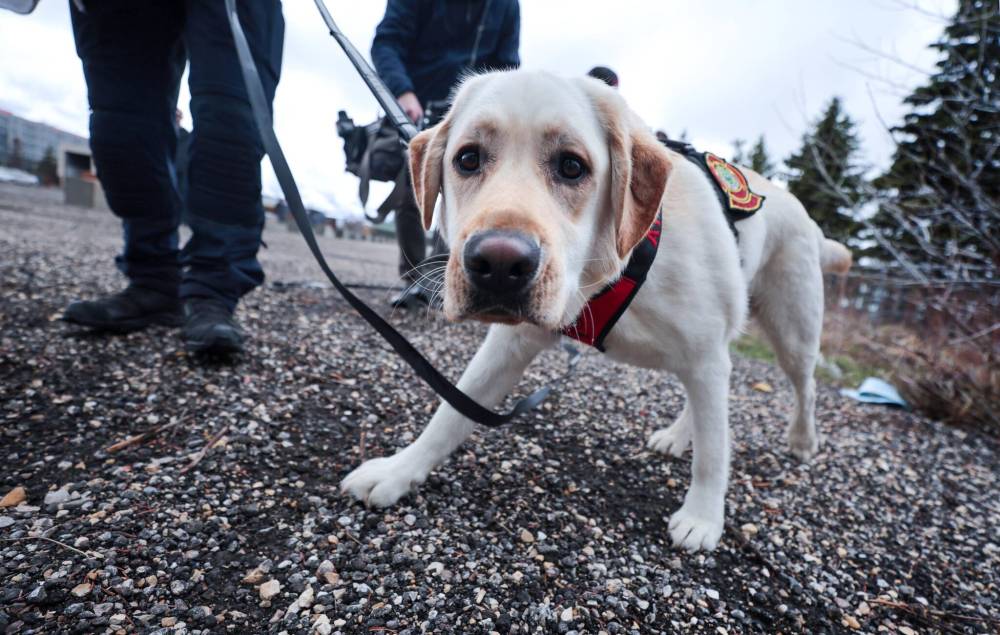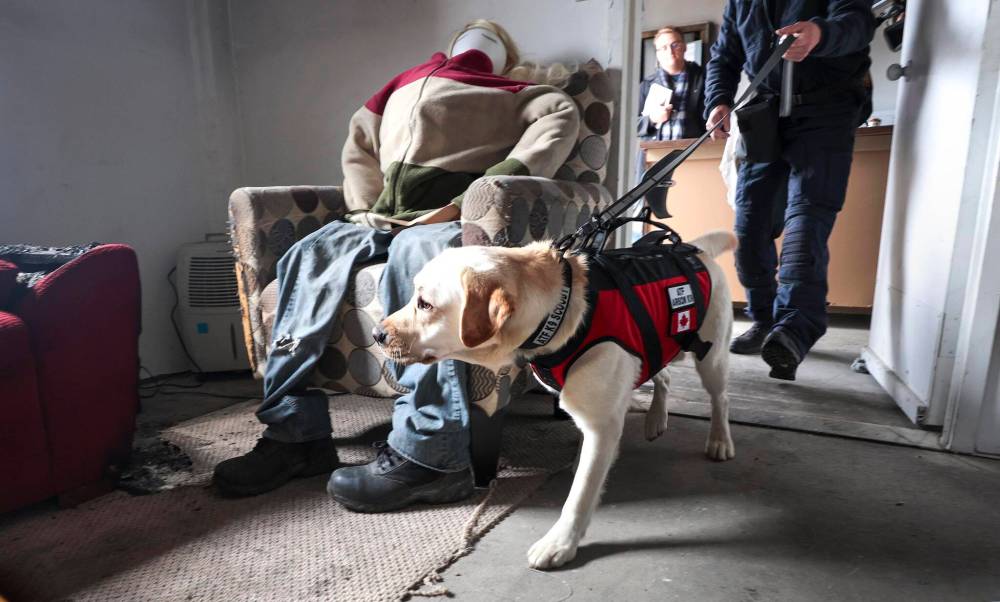
A dog trained to detect accelerants will help investigators probe arsons, officials say, as vacant and derelict buildings burn to the ground with increasing regularity.
Scooby, a one-and-a-half-year-old yellow Labrador, trained along with a Winnipeg Fire Paramedic Service handler at the U.S. Bureau of Alcohol, Tobacco, Firearms and Explosives’s canine program in Virginia, after talks between the fire department, police and the American agency’s attaché to the U.S. embassy in Ottawa.
The trained handler and dog, who completed in the program late last month, are a first for a Canadian fire department, WFPS fire investigations chief officer Jason Fedoriw said as Scooby was introduced at a news conference Friday.
[embedded content]
The dog is trained to sniff out accelerants possibly used to light fires — such as fuel, alcohol and other flammable solvents — and point them out at the scene to its handler.
WFPS Deputy Chief Scott Wilkinson said the dog’s trained nose will help collect evidence for police to make arrests and the courts to convict those responsible for arsons. Mayor Scott Gillingham said there’s an unfortunate need for the canine’s work with the high number of fires in Winnipeg.
“We know that a lot of the fires are happening in vacant and derelict buildings, full stop, we have too many vacant, derelict buildings in our city, and as a council … we’re working hard with our departments to address that issue,” the mayor said.
Wilkinson said the causes of many fires in the city, including in vacant buildings, are undetermined because of the nature of the damage and other factors. The dog will be able to collect evidence that investigators aren’t currently able to at some scenes.
“We are fairly confident that it’s going to help with that identification, to help determine a little more conclusively which fires are potentially incendiary, or set using accelerants, and it could lead to arson prosecutions,” Wilkinson said.
Fedoriw said fire investigators interview crews who respond to blazes, photograph the scenes, and examine and collect data. Forensic scientists analyze the evidence in a lab.
He said the investigations are time-consuming, particularly as multiple fires often occur at the same time. Scooby is expected to help speed up the probes and lessen fatigue for investigators.
Once fire investigators determine a blaze is suspicious, Winnipeg Police Service major crimes investigators take charge. Major crimes Insp. Jennifer McKinnon said arson investigations are notoriously difficult.
RUTH BONNEVILLE / FREE PRESS Scooby, a one-and-a-half-year-old yellow Labrador, trained along with a Winnipeg Fire Paramedic Service handler at the U.S. Bureau of Alcohol, Tobacco, Firearms and Explosives’s canine program in Virginia.
“Fire investigations are very unique, arson investigations, because there’s a lot of factors at play,” McKinnon said.
“The fire has destroyed the structure, the place is no longer in the same condition it was when the suspect was in there. The fire department has now gone in and done their thing to put that fire out, and I think from a forensics perspective, to identify origin and cause is very challenging right now … To lay a criminal charge, we need origin and cause.”
Arrests in 8% of arsons last year
Of 494 general arson investigations in Winnipeg last year, police made arrests in about eight per cent of them, statistics show.
However, arrest rates for arsons with a disregard for life — a different charge, classified as a violent crime — were much higher. Police made an arrest in 81 per cent of the 21 violent arsons logged during the same period.
McKinnon said she’s “very optimistic” the dog will allow police to make more arson arrests.
WFPS Chief Christian Schmidt said the number of fires in Winnipeg, which are higher than comparable Canadian cities, is tied to population growth, socioeconomic factors and older housing stock, as well as increasingly dry weather. He thinks the addition of a dog will make Winnipeg safer.
The city reported 125 vacant building fires — a record — for 2023, up to Nov. 15. Full year-end figures, or ones for 2024, are not yet available. Figures for total fires last year are also not yet available. There were 2,545 fires in 2022.
In Winnipeg, 12 fatalities were linked to blazes and more than 500 fire investigations in 2023.
RUTH BONNEVILLE / FREE PRESS Scooby snoops through areas mocked up as possible arson fires to find an accelerant with his trainer.
Last summer, the City of Winnipeg announced it would crack down on building owners who let properties go into disarray by amending the vacant building bylaw to fine them for firefighting costs.
The fire department, police and city bylaw office also work together to attempt to address vacant buildings before fires alight.
The three services work in a team that goes from property to property on a vacant building list, clearing them of squatters and identifying hazards, before a contractor boards the buildings up.

Erik Pindera
Reporter
Erik Pindera reports for the city desk, with a particular focus on crime and justice.
Read full biography


